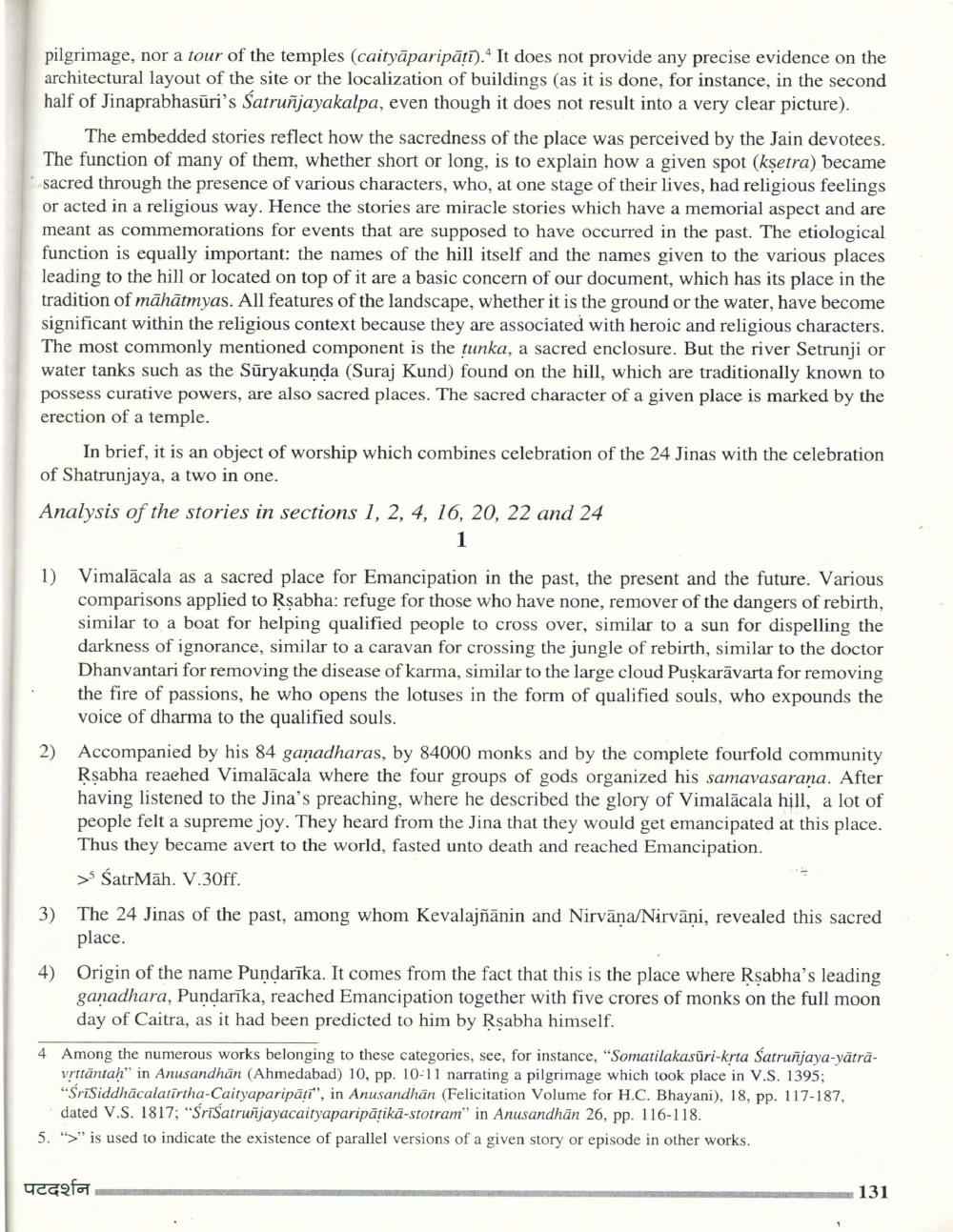________________ pilgrimage, nor a tour of the temples (caityaparipati). It does not provide any precise evidence on the architectural layout of the site or the localization of buildings (as it is done, for instance, in the second half of Jinaprabhasuri's Satrunjayakalpa, even though it does not result into a very clear picture). The embedded stories reflect how the sacredness of the place was perceived by the Jain devotees. The function of many of them, whether short or long, is to explain how a given spot (ksetra) became sacred through the presence of various characters, who, at one stage of their lives, had religious feelings or acted in a religious way. Hence the stories are miracle stories which have a memorial aspect and are meant as commemorations for events that are supposed to have occurred in the past. The etiological function is equally important: the names of the hill itself and the names given to the various places leading to the hill or located on top of it are a basic concern of our document, which has its place in the tradition of mahatmyas. All features of the landscape, whether it is the ground or the water, have become significant within the religious context because they are associated with heroic and religious characters. The most commonly mentioned component is the tunka, a sacred enclosure. But the river Setrunji or water tanks such as the Suryakunda (Suraj Kund) found on the hill, which are traditionally known to possess curative powers, are also sacred places. The sacred character of a given place is marked by the erection of a temple. In brief, it is an object of worship which combines celebration of the 24 Jinas with the celebration of Shatrunjaya, a two in one. Analysis of the stories in sections 1, 2, 4, 16, 20, 22 and 24 1) Vimalacala as a sacred place for Emancipation in the past, the present and the future. Various comparisons applied to Rsabha: refuge for those who have none, remover of the dangers of rebirth, similar to a boat for helping qualified people to cross over, similar to a sun for dispelling the darkness of ignorance, similar to a caravan for crossing the jungle of rebirth, similar to the doctor Dhanvantari for removing the disease of karma, similar to the large cloud Puskaravarta for removing the fire of passions, he who opens the lotuses in the form of qualified souls, who expounds the voice of dharma to the qualified souls. Accompanied by his 84 ganadharas, by 84000 monks and by the complete fourfold community Rsabha reached Vimalacala where the four groups of gods organized his samavasarana. After having listened to the Jina's preaching, where he described the glory of Vimalacala hill, a lot of people felt a supreme joy. They heard from the Jina that they would get emancipated at this place. Thus they became avert to the world, fasted unto death and reached Emancipation. > SatrMah. V.30ff. 3) The 24 Jinas of the past, among whom Kevalajnanin and Nirvana/Nirvani, revealed this sacred place. 4) Origin of the name Pundarika. It comes from the fact that this is the place where Rsabha's leading ganadhara, Pundarika, reached Emancipation together with five crores of monks on the full moon day of Caitra, as it had been predicted to him by Rsabha himself. 4 Among the numerous works belonging to these categories, see, for instance, "Somatilakasuri-krta Satrunjaya-yatra vrttantah" in Anusandhan (Ahmedabad) 10, pp. 10-11 narrating a pilgrimage which took place in V.S. 1395; "SriSiddhacalatirtha-Caityaparipati", in Anusandhan (Felicitation Volume for H.C. Bhayani), 18, pp. 117-187, dated V.S. 1817; "Srisatrunjayacaityaparipatika-stotram" in Anusandhan 26, pp. 116-118. 5. ">" is used to indicate the existence of parallel versions of a given story or episode in other works. पटदर्शन 131




